敦煌莫高窟(英文ppt介绍)资料50页PPT
- 格式:ppt
- 大小:7.80 MB
- 文档页数:50
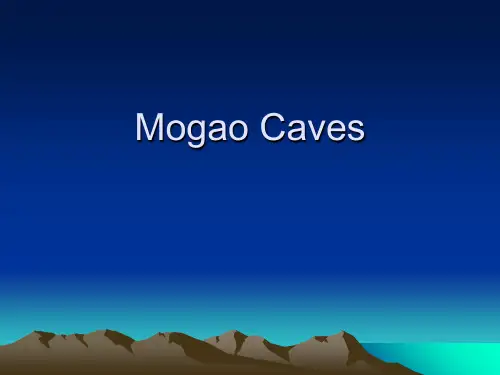

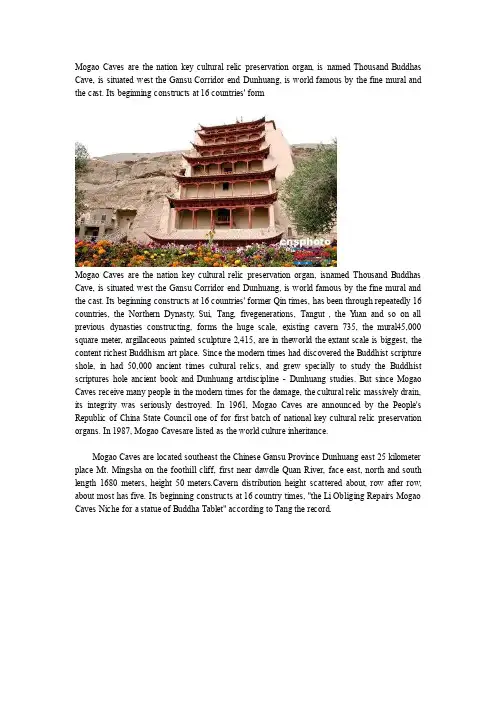
Mogao Caves are the nation key cultural relic preservation organ, is named Thousand Buddhas Cave, is situated west the Gansu Corridor end Dunhuang, is world famous by the fine mural and the cast. Its beginning constructs at 16 countries' formMogao Caves are the nation key cultural relic preservation organ, isnamed Thousand Buddhas Cave, is situated west the Gansu Corridor end Dunhuang, is world famous by the fine mural and the cast. Its beginning constructs at 16 countries' former Qin times, has been through repeatedly 16 countries, the Northern Dynasty, Sui, Tang, fivegenerations, Tangut , the Y uan and so on all previous dynasties constructing, forms the huge scale, existing cavern 735, the mural45,000 square meter, argillaceous painted sculpture 2,415, are in theworld the extant scale is biggest, the content richest Buddhism art place. Since the modern times had discovered the Buddhist scripture shole, in had 50,000 ancient times cultural relics, and grew specially to study the Buddhist scriptures hole ancient book and Dunhuang artdiscipline - Dunhuang studies. But since Mogao Caves receive many people in the modern times for the damage, the cultural relic massively drain, its integrity was seriously destroyed. In 1961, Mogao Caves are announced by the People's Republic of China State Council one of for first batch of national key cultural relic preservation organs. In 1987, Mogao Cavesare listed as the world culture inheritance.Mogao Caves are located southeast the Chinese Gansu Province Dunhuang east 25 kilometer place Mt. Mingsha on the foothill cliff, first near dawdle Quan River, face east, north and south length 1680 meters, height 50 meters.Cavern distribution height scattered about, row after row, about most has five. Its beginning constructs at 16 country times, "the Li Obliging Repairs Mogao Caves Niche for a statue of Buddha Tablet" according to Tang the record.Former Qin establishes a reign title for two years (366 years), the Buddhist priest happy goes via this mountain, sees the golden light sparkle suddenly, if presently ten thousand Buddha, therefore then opened cutting on the dike the first cavern.Hereafter the law good Zen master and so on continues in this to construct the hole to repair the imperial sacrifices, is called the desert high hole, Italy is the desert high place.Because later generation desert and not general, then renames as Mogao Caves.When Northern Wei Dynasty, Western Wei Dynasty and Northern Zhou Dynasty, the ruler respects and believes in Buddhism, the rock cave construction has the nobility support, the development is quick.The Sui and Tang dynasties time, along with Silk Road prosperity, Mogao Caves is prosperous, when Wu Zetian has cavern thousand.After the Anlushan Rebellion, Dunhuang successively and turns over to the troops fighting in a good cause by Turfan to seize, but the statuary activity too greatly has not been affected.The Northern Song Dynasty, the tangut and the Y uan Dynasty, Mogao Caves gradually hasten the decline, only repaired the previous dynasty hole room primarily, newly built extremely few.After Y uan Dynasty, along with Silk Road abandoning, Mogao Caves also stopped constructing and is neglected gradually in common people's field of vision.After clear Kanghsi 40 years (in 1701), here only then again manner attention.The modern times, people usual name it “Thousand Buddhas Cave.The Mogao Caves extant Northern Wei Dynasty to Y uan cavern 735, divides into the north and south two areas.South the area is Mogao Caves' main body, is engaged in the religious activities for the clergy the place, some 487 caverns, have the mural or make an idol.North the area has 248 caverns, in which only then 5 existence murals or makes an idol,But after other all is the clergy leads a pious life the place which, the housing and the death buries, has life facilities and so on the adobe bed, stove kang, flue, niche, desk lamp.Two area total 492 cavern existence mural and makes an idol, has the mural 45,000 square meter, the argillaceous painted sculpture 2415, Tang Songmu constructs cliff eave 5, as well as several thousand lotus flower pillars, spread out on the floor the decorative brick and so on.。
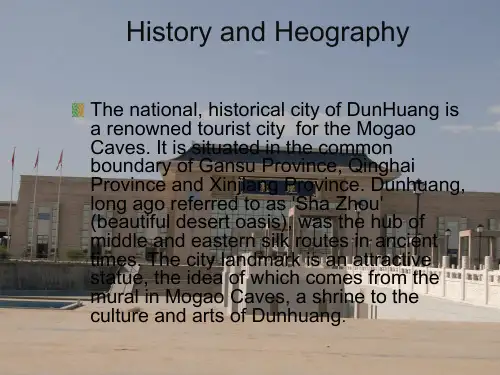
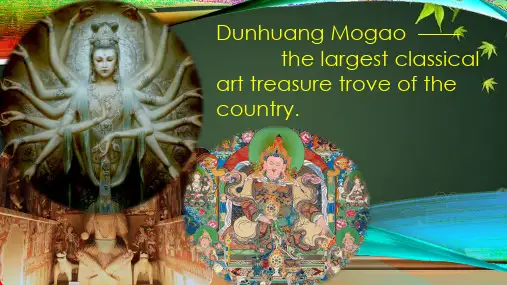
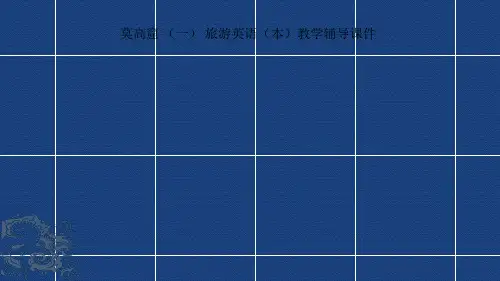
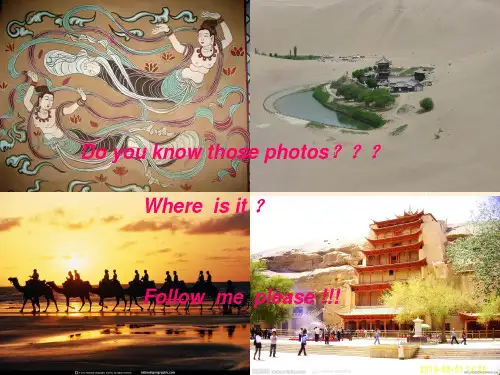
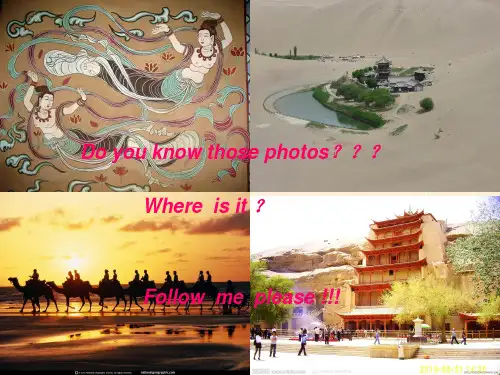
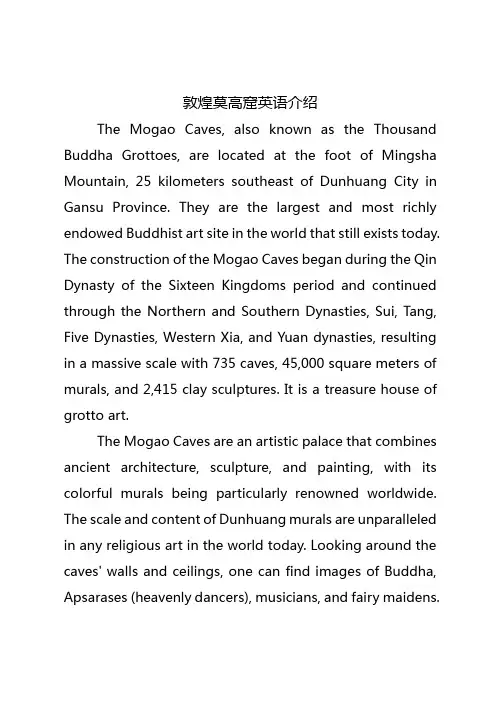
敦煌莫高窟英语介绍The Mogao Caves, also known as the Thousand Buddha Grottoes, are located at the foot of Mingsha Mountain, 25 kilometers southeast of Dunhuang City in Gansu Province. They are the largest and most richly endowed Buddhist art site in the world that still exists today. The construction of the Mogao Caves began during the Qin Dynasty of the Sixteen Kingdoms period and continued through the Northern and Southern Dynasties, Sui, Tang, Five Dynasties, Western Xia, and Yuan dynasties, resulting in a massive scale with 735 caves, 45,000 square meters of murals, and 2,415 clay sculptures. It is a treasure house of grotto art.The Mogao Caves are an artistic palace that combines ancient architecture, sculpture, and painting, with its colorful murals being particularly renowned worldwide. The scale and content of Dunhuang murals are unparalleled in any religious art in the world today. Looking around the caves' walls and ceilings, one can find images of Buddha, Apsarases (heavenly dancers), musicians, and fairy maidens.The Mogao Caves are a large grotto temple that integrates painting, sculpture, and architectural art. Its main grotto types include meditation caves, central tower caves, hall caves, central Buddha altar caves, three-alcove caves with four walls, giant statue caves, and Nirvana caves. The sizes of the various caves vary greatly; the largest, Cave 16, covers an area of 268 square meters, while the smallest, Cave 37, is only a few inches high. There used to be wooden halls outside the caves connected by corridors and plank roads, but most have now disappeared.In conclusion, the Mogao Caves are a place worth visiting for their long history and profound cultural heritage. They are well-preserved and allow visitors to experience the charm of ancient civilization up close.翻译:敦煌莫高窟,又称千佛洞,位于甘肃省敦煌市东南25公里处的鸣沙山麓脚下,是世界上现存规模最大、内容最丰富的佛教艺术地。
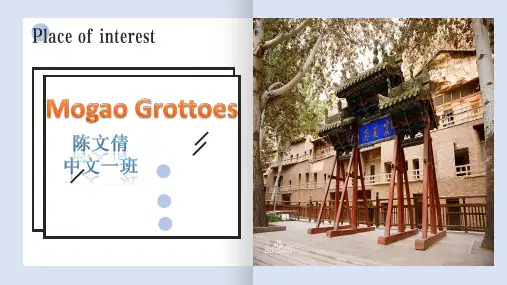

莫高窟(mògāo kū)Mogao GrottoesSpiritual, artistic and architectural wonders The Mogao Grottoes in northwest China are the greatest Buddhist caves, and the second oldestafter the Qiuci Grottoes in Xinjiang Uygur Autonomous Region still in existence in the countrytoday.Also known as the Caves of a Thousand Buddhas, the grottoes are about 25 kilometers southeastof Dunhuang in Gansu Province, a strategic center for trade, as well as a hub for cultural andreligious exchanges on the Silk Road in ancient times.Construction of the caves began in the 4th century AD. According to a legend, Buddhist monk Le Zun saw 1,000 Buddhas bathed in golden light at thesite. He then decided to dig a cave into the cliff to create a place for mediation while pursuing hisquest for enlightenment.Gradually, more Buddhist monks came here to dig caves into the cliff of the east range of MountMingsha. The caves served as both their homes and places to meditate.Later, caves began to be carved out of the southern side of the cliff to serve as places for worshipand pilgrimage.By the T ang Dynasty (618–907 AD) there were more than 1,000 grottoes.Today, 735 caves, which contain numerous murals and 2,415 statues of Buddha, still exist.Distributed on four levels and stretching 1,680 meters from south to north, the floor space ofeach cave varies from more than 200 square meters to less than one square meter.Since the grottoes on the north section of the cliff once served as mediation chambers, livingquarters and burial sites, they are simpler in design. But those on the south section are richlypainted and built in various styles as places for worship and pilgrimage.The main chambers of these caves feature distinctive architectural styles such as chaitya, nirvanaand grand Buddha.Cave No. 96 houses a sitting statue of Buddha measuring 35.6 meters in height.The chaitya style has a square-sectioned column standing in the center of the chamber,representing Buddha. Worshipers would circle around the column seeking blessings.Grottoes in the nirvana style are usually a rectangular chamber with a landscape orientation. Astatue of a reclined Buddha is placed on a platform built along the back wall and open forworshipers.A cave for a grand Buddha statue is often built according to the size of the statue. For instance,Cave No. 96 houses a sittingstatue of Buddha measuring 35.6 meters tall. It is made of stone andcolored with clay.Such caves all have a square base and the walls taper toward the ceiling, which is usually in theshape of a dome or a flat-top pyramid.Cave No. 96 was built in the early years of the Tang Dynasty. The cave is inside a tall andgrandiose pavilion featuring nine flying eaves, which were rebuilt in the 1930s.There are also caves that imitate traditional Chinese buildings and Buddhist architecture.Some of the grottoes once had wooden porches, but they have nearly all been lost due toerosion or destruction. There are several relatively well-preserved extant wooden eaves at the entrance of some caves.They are rare samples of the wooden structures prevalent in the Tang and Song (960–1279)dynasties.The large murals inside the caves have great artistic value. However, they are also treasured byarchitects and historians since they depict ancient buildings such as palaces, temples, pavilions,city walls, tents, bridges, prisons, beacon towers,taverns, wine shops and tombs.In 1987, the Mogao Grottoes were added to the list of UNESCO World Heritage Sites. Today it isone of the most popular tourist attractions in the country.Buddha statues in Maiji Mountain Grottoes Pictorial dictionary·石窟寺(shíkūsì) cave templeCave temples are a type of rock-cut architecture that China first introduced from India in the 3rdcentury AD, when Chinese Buddhist monks began to build caves in cliffs and used themasmediation chambers and living quarters.Later, more caves were chiseled out to serve as Buddhist temples for worship and pilgrimage.The best-known cave temples in China include the Mogao Grottoes, Maiji Mountain Grottoes,Yungang Grottoes and Longmen Grottoes. They are all fine examples of Chinese Buddhist art,combining architecture with sculptures and paintings.Most of these caves were built in one of six distinctive architecture styles.One is called chaitya, featuring a square-section column in the center of the cave. Worshiperscircle the column seeking blessings.Some large grottoes were built to house large Buddha statues, some of which are nearly 40meters tall.Others have combined the Buddhist style with traditional Chinese buildings.Cave temples have long been deemed a part of ancient Chinese architecture.。
莫高窟英语介绍Mogao Grottoes is a famous treasure trove of cave art in China, located in Mogao Valley, Dunhuang City, Gansu Province. It is the largest and most abundant Buddhist art site in the world, and also one of the treasures of ancient Chinese art. The Mogao Grottoes were first built during the Pre Qin period of the Sixteen Kingdoms period, and have undergone construction and development during historical periods such as the Sixteen Kingdoms, Northern Dynasties, Sui, Tang, Five Dynasties, Western Xia, and Yuan, forming the current scale.The total area of Mogao Grottoes has reached 45000 square meters, divided into three parts: east, middle, and west, with a total of 735 caves. Among them, there are 492 well preserved caves, with over 45000 square meters of murals and over 2415 sculptures. These caves and mural sculptures are renowned for their exquisite artistic techniques and rich subject matter content.The murals in Mogao Grottoes mainly depict Buddhist stories, the life stories of Buddha, and important scenes in Buddhist scriptures. These murals not only have high artistic value, but also have important significance for studying ancient Chinese society, culture, religion, and other aspects. The sculpture works of Mogao Grottoes are also unique, featuring typical features of the Tang Dynasty and incorporating the influence of Western culture, forming a unique style.The murals and sculptures of Mogao Grottoes occupy an important position in the history of ancient Chinese art. They not only showcase the brilliant achievements of ancient Chinese art, but also reflect the historical process of cultural exchange andintegration between East and West. The Mogao Grottoes are therefore known as the "treasure trove of Eastern sculpture art".The Mogao Grottoes are not only renowned in China and even globally, but also one of China's important tourist attractions. Every year, it attracts a large number of domestic and foreign tourists to watch and study. In order to protect the valuable cultural heritage of the Mogao Grottoes, the Chinese government has taken a series of measures, such as limiting the number of tourists and strengthening the protection of cultural relics. At the same time, modern technological means have been utilized for digital protection and research of the Mogao Grottoes, in order to better inherit and showcase this valuable cultural heritage.In short, the Mogao Grottoes, as one of the treasures of ancient Chinese art, are renowned for their rich and diverse murals and sculpture works. It is not only a treasure of ancient Chinese art, but also a witness to the exchange and integration of Chinese and Western cultures. By protecting and inheriting the precious cultural heritage of the Mogao Grottoes, we can better understand and appreciate the glorious achievements of ancient Chinese art. At the same time, the Mogao Grottoes also provide visitors from all over the world with a window to learn about ancient Chinese culture and art.。